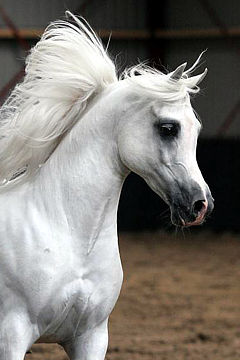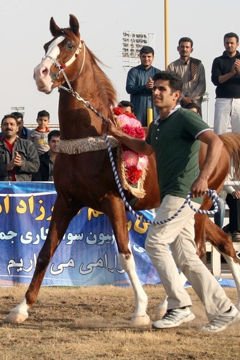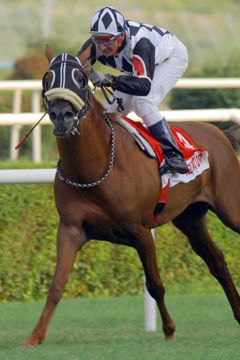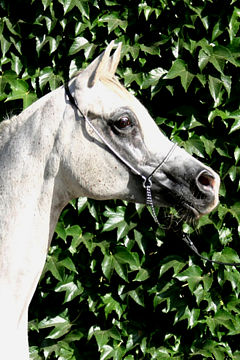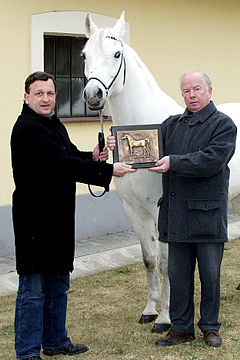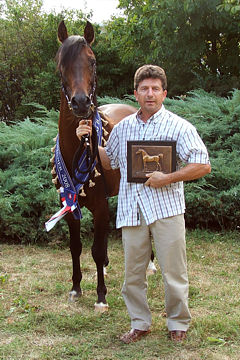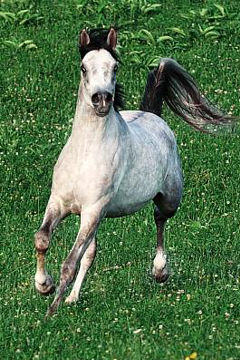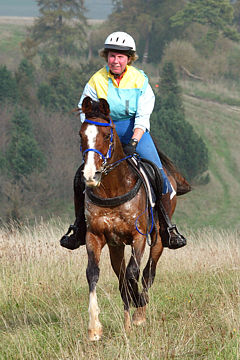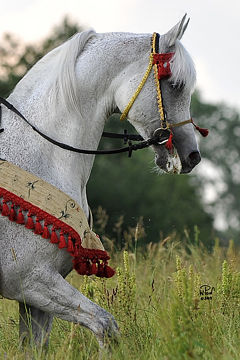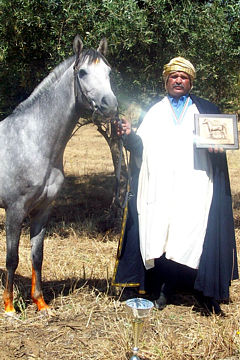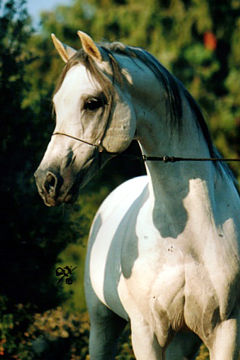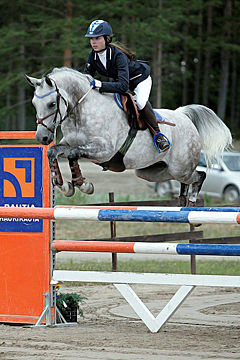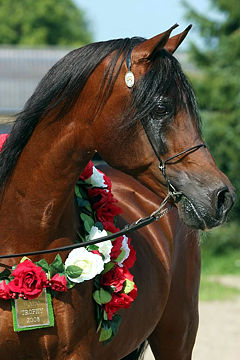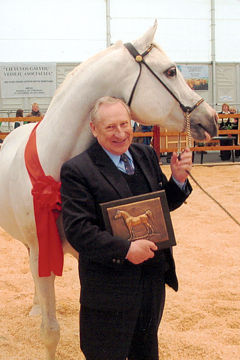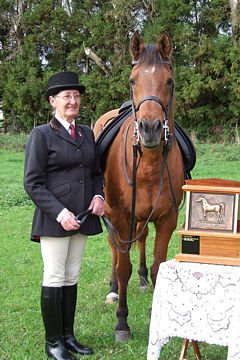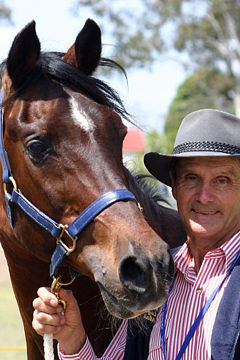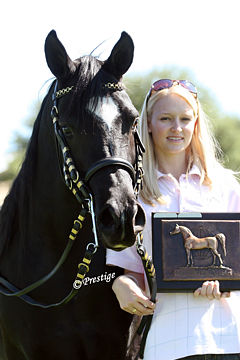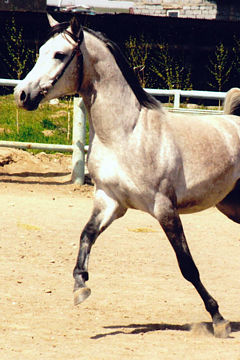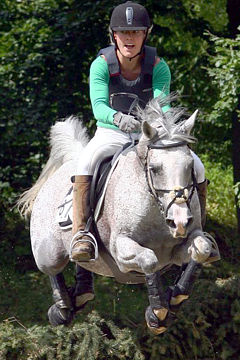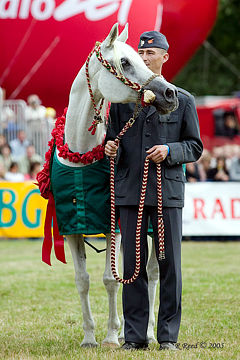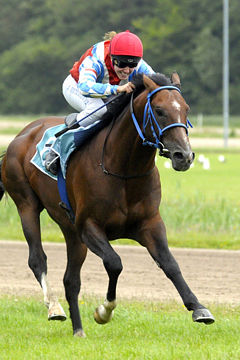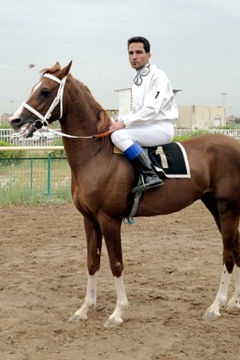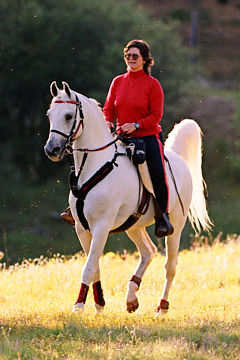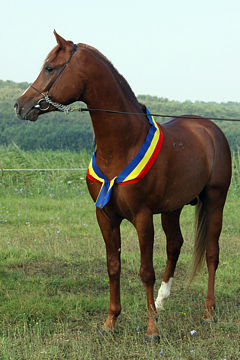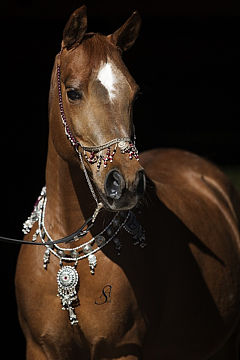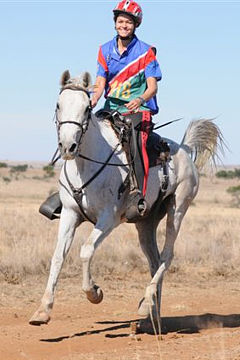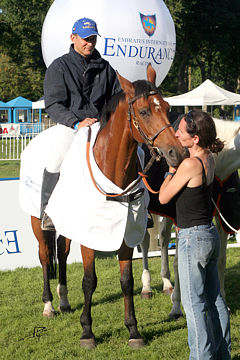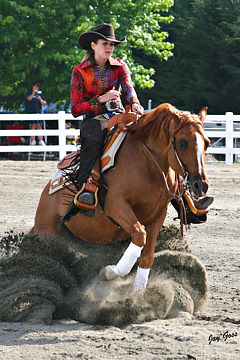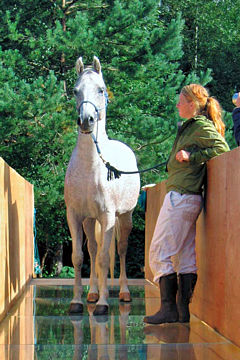I have read many books and articles about the Asil (Arab) horse. However, except for two books – one by Mohammad Ali Pasha of Egypt, in which he says the reason he is writing on the Asil is because he is tired of reading books written on this subject by westerners, according to him often incorrect; and the second a translation in French of a book written by the Arab writer, Ibn Hodeil, in the fourteenth century – all the rest have not only been by outsiders, they have been by people who had a personal interest and had purchased from one source or another. Certainly in such cases they were biased in favor of what they had obtained. In most cases all the tradition and history that went into the producing of this breed of horse which has become world famous is ignored.
It is difficult to explain to those with a cursory acquaintance with the original Asil breeder of the relationship and reasons of how they relate to their horses. I have not seen this understanding except in the book “Nineveh and Babylon” written by Layard, an English traveller, adventurer and excavator of the Assyrian capitol of Nineveh. He is not on an equine search, but living and working with Arabs he devotes a few pages of his book to the horse. He comments on the fact that Abbas Pasha (Viceroy of Egypt and great collector of Asils), at a time when the highest price given for horses bought by dealers for foreigners was one hundred and fifty English pounds, was unable to obtain a particular mare although he offered the owner one thousand two hundred pounds, because “Without his mare, money was of no value to him.” He then makes a comment of great interest, particularly as it indirectly concerns our Asil in Khuzestan, when he says: “From the Khamseh have sprung a number of families no less noble, perhaps, than the original five; but the Shammar receive their stallions with suspicion or reject them altogether. Among the best known are the Wathna Khersan, so called from the mares being said to be worth their weight in gold. Noble horses of this blood are to be found amongst the Arabs inhabiting the east of the Euphrates (the Bani Lam, Al Khamees, and Al Kathir).”
This brings me to the Asil of Khuzestan, where the strain system of breeding is still maintained today. One of the equine families highly esteemed by all is still the Wadnan Khersan, female referred to as Wadne Khersani, mentioned by Layard. Having looked through several of the better known western stud-books, I have never seen a pedigree whose foundation claimed to be of this line. Only Brown has the Wadnan Khersan as a sub-strain of the Koheilan, then again separate by itself, having gained the fame to be considered an entity on its own. The information given by Layard clears up this puzzle.
Of the tribes mentioned by Layard in the first quotation, branches of the Al Khamees, Al Kathir and the Bani Lam are existent today in Khuzestan. The Bani Lam and the Al Kathir are known for the foundation of certain strains, the former for the Saglawi Djadrani, and Nesman (branch of the Koheilan), the latter for the Hamdani Semri, Saglawi Djadran, Wadne and a Wadne branch known as the Zaghieh. The Kaab, under whose name General Tweedie recognizes the Arab of Iran, are a large tribe divided into sub-tribes. Those best known for certain strains are the Jassemi for the Hetli (a Koheilan derivative) and the Sofferieh (a Saglawi sub-strain); the Mojadami known for a branch of the Hamdani, the Sobeili and Beaiyreh (Wadne Koheili). There are the Bani Khalid famous for Soffeirieh and Djelfe (Julfa to Layard); the Seyyids of Hosseini with the Maanghieh (Maneghi); the Seyyids of Tefagh with the Koheilan Adjuz, the Nesman and the Djelfe; and the Ziareh are best known for their Saglawis. However, the strain whose stallion is accepted by everybody as
faal (worthy for breeding ) is the Wadnan Khersan of the Mir tribe, who also own the best considered Obayan Sharak. Up to this day no mare of this line has never been sold, nor have any even been exchanged or given as gifts to other tribes, a custom normal among most Arabs.
Early in the history of the exodus of the Asil from its homeland the strain system was ignored. The regulations of breeding allow the breeding of a mare of the Khamseh to stallions of another Khamseh strain, but the foal will be known by its dam’s strain. If it is a filly it may again be bred to a third strain, and so on, however, the descendants will always be known by her dam strain. This system of following of the dam strain, whatever the sire, was ridiculed and discarded by many in the west. Good reason, for if anyone wished to follow it they would have had to obtain large numbers to make it possible. The above was given as an example, though in fact among those breeders of name and their tribes, I doubt if this often happened. The stallions were kept by the Sheikh for use by his tribe. Normally, as described above, a tribe or known family did not have more than two or three strains, usually breeding back to the original strain every second, or at most third generation. In truth, in my experience of fifty years in Khuzestan, the greater danger is in-breeding. It would cause the displeasure of the sheikh if members of his clan took their mares to be bred by someone else’s stallion. In any case, today with the advanced studies of genetics, it has been found that many traits are carried only through the female line. It would appear the Arab somehow was using the correct method.
Aside from the Arab tribes, members of two of their northern neighbours, two big migratory tribes the Lurs and the Bakhtiari, obtained Asil horses and the traditions that went with them. It was through the Bakhtiari that I came to know and admire the Asil horses of Khuzestan.
Although I had ridden since I was a child, my association with the Asil started when I married Majid Bakhtiar. He was a member of the chiefs of the Bakhtiari, a tribe inhabiting the region west and south-west of the province of Isfahan, with winter quarters in the northern boundaries of Khuzestan. He owned properties in this province, also a stable of pure-bred Asil horses for which the region was famous, both inherited from his father. The horses that had been obtained by his family, who were at one time powerful, were mostly as presents from sheikhs with whom they had alliances. Others were taken in battle, such as two Wadne Khersani mares from the Mir tribe. Gradually, I learnt the rules and regulations that were considered necessary for the breeding of Asils, taught by him and by those with knowledge of the old traditions.
At the time of my marriage I owned two what I considered to be superior horses, non Arabians of partly foreign breeding which I had obtained at exorbitant prices after long searches to find them. I was very proud of them and had every intention of taking them with me if we were to live in the south. Majid objected, saying he had a whole stable full of horses that I could choose from. We finally agreed that no decision would be taken until such time that I had seen his Asils. When I eventually did, I made the most uncomplimentary comment regarding this breed. Even now I bite my tongue when I recollect that day and the expression on Majid’s face. What I said was: ” Majid, how can you call these horses! They are goats !”
Eventually, I insisted on taking down one of my “superior” horses. In the meantime Majid had given me a flashy chestnut colt of the Wadnan Khersan strain, highly esteemed by his father and himself. He also bought a black Obayan Sharak stallion from a neighbouring Arab sheikh, which he gave to me. Within a year I had given away my “superior” horse. This is the way it came about.
We had commenced a very big mechanized farm, mainly at that time dry farming, wheat and barley, on land rented from the government, the whole over eight thousand hectares. I managed the internal affairs of this activity, usually attending to the land on horseback. One lovely spring evening, riding the black stallion, I was cantering quietly, in a pace taught by Arab trainers, to one of our field camps. Suddenly the horse bolted. I was not too worried about stopping him, but was puzzled by his action. I thought possibly dogs or hyenas were silently chasing us. I looked behind me. Nothing. I turned back, and Zip, Zip, Zip, one, two, three gazelle went flashing across my path! This horse was a hunter!
Gazelle hunting on horseback had become almost obsolete. After this incident, having heard many fireside tall tales of feats performed in the past by this horse or that man, I so ridiculed the present inability to compete as before, that Majid and several other of the Bakhtiari took it up with a vengeance. The method used in Khuzestan needed a great deal of patience, and good judgement of speed and distance. The chances of the gazelle escaping were about 75%. The hunters, once they spotted gazelle, would start riding at walk in a large circle around them, usually not more than two hunters together, slowly decreasing the circle. The gazelle would become agitated, jog off a short distance, stop, change direction, start off again, and eventually go into a canter. All this while the stalker must keep calm, keeping his pace to no more than a fast walk. Not yet. Not until the gazelle makes up his mind as to the direction of his escape and goes into what the Bakhtiari call “a smooth run”, in other words flat out. Now nothing will persuade him to change his direction.
This is when the hunter “unleashes” his horse at a converging course diagonal to that of the gazelle. In this first burst of speed the gazelle can do something like 90 kph, thus the need for proper calculation! The horse is galloping full out. He has his head, for the reins are gathered loosely in the left hand which is at the same time supporting the barrel of the gun. Once this sport was done with bow and arrow, thus both hands were completely occupied! The terrain is normally flat, but this does not exclude rocks, rat & fox holes, dry flood beds, etc. It is the horse who must make the decisions whilst going at full speed. The distance he must run depends on the angle and speed of horse and gazelle. Choosing the angle and manoeuvers when nearing the gazelle is where an expert hunter is separated from the stupid or amateur. The gazelle should pass within convenient shooting distance in front of him. Too slow, the gazelle is gone. Too fast, they will pass behind him. He will then not only have to be a good shot, he will also have to be a good acrobat!
In this world of gazelle chasing, hunting wild boar in muddy marshland and dense brush, using horses as transport, accompanying tribes on torturous mountain tracks, the horses I had dismissed as “goats” could not be compared with any other horse. On our first migrations some of the horses were urged up riderless over the boulders strewn on the steep mountain climbs. Likewise they needed help taking the sharp turns down the slippery descents, where the rocky surface shone like glass from centuries of use. Two years later, these same horses clambered up and down like mountain goats, outdoing the local tribal horses and sometimes even the mules! They were incredible! My Asil ‘disease’ became confirmed at this point and was to remain with me thereafter, playing a major role in my future life.
During the years of my marriage to Majid Bakhtiar, I was in charge of the management and breeding of his stock. It was a great blow to the Asil of the province when in the forties it was struck by an epidemic of African Horse Plague. Many strains were wiped out, and others decimated. For some reason those horses which survived were mostly the old or the very young. Out of eighty four horses of our stables only sixteen remained, notwithstanding that the first vaccinations started there. In most areas it was far worse. Many people became discouraged, having lost many of their best horses. We also felt the same way. It took a few years for the shock to wear off and the interest in breeding to take root again. However, since for the tribes of Khuzestan the owning of Asil mares was deeply woven with tradition, whoever had even one mare remaining held onto her. Those who had lost everything arranged to obtain at the least half of a pure mare from a friendly tribe. Most people kept the one mare, breeding her only when she started to age, and as soon as she produced a filly they would stop breeding. The filly was then kept with the same conditions. Male foals were no longer killed but were given away to non Arabs, or if they were of superior quality would be given as presents to officials with an interest in horses.
Majid’s stables had increased to about forty head, when he was killed in a plane accident. His stock was then donated to the Royal Horse Society of the time. Not long afterwards they were accepted by WAHO, although those of Khuzestan, the foundation of all the Asil of Iran, were not immediately accepted until we could provide proof of control of breeding. It was during this period that I found friends among Arab horse breeders elsewhere in the world, among them Gustl Eutermoser and Ulrika Marcik who I met in Sweden. They asked if they could come to visit me. I explained that I lived in an isolated area, the road somewhat undefined and my home hard to find. However, I gave them a primitive map and thought little more about it.
Quite late one rainy night sometime in the early spring of Khuzestan, the rainiest season of all, I heard the horn of a car at the gate. A Range Rover entered the courtyard. I was surprised, for the only person I knew with such a car would not have chosen such a wet night. Not only was the road bad, but there was a river to cross which, though not wide, could have dangerous flash floods. My surprise was all the greater when out of the car descended Gustl and Ulrika, together with a lady from Australia and a man from Germany. For two days we had hurried, dripping visits to the stables, not very pleasant in the incessant rain. Bored, they asked me if there was a sheikh we could visit, who was reputed for his traditional knowledge of the Asil? Sheikh Hajat of the Al Kathir, said to be one of the most authoritative men on the dispersal and fame of the strains of Khuzestan, lived not more than forty kilometers away. It was at the risk of becoming stuck in the mud that we decided to attempt to go to him. We had a fantastic drive which was more like sailing on a sea of mud than driving, but we eventually got there, cold and very wet.
Sheikh Hajat, whom I knew well, was very glad to see us. He had been a good friend of Majid’s and was one of my instructors in the field of the Asil of Khuzestan. He had an enormous brazier of red-hot charcoal set before us, and once we were warmed by tea and coffee, the conversation turned to my guests and the reason for their presence. They wanted his opinion as to the qualifications of a good Asil horse. He said: “First ask them which horse they are talking about. The horse of the “khiaban” (avenue, meaning a horse for showing off, festivities etc.) or a horse of the “biaban”? (the desert or the wilderness, meaning a horse for fighting, long distances, speed for hunting etc.) The reply was “the horse of the biaban”.
He then replied: “First, before looking at the horse’s body, you must ensure that it has the five specifications of character: Courage. Intelligence. Stamina. Spirit. Above all “Nejabat” (a difficult word to translate, a mixture of nobleness, gentleness and the ethics of an aristocrat). If it lacks these virtues, no matter how pleasing he is to the eye, he is a worthless horse, so do not waste your time. If he has them then run your eyes over his conformation. The forehead should be wide, the eyes large and alive, the ears well placed and alert, the neck connection slender and refined, the shoulder sloping, the girth deep, the cannon short, the distance between the knees to come straight down to the ground” and so on. In short, many of his stipulations were similar to the opinions held by many writers, except when it came to the head, croup and tail carriage. He did not approve of the dish. He had seen it in exaggerated form on a stallion sent as a present from the States and considered it a deformity. The completely flat croup, he said, was pleasing to the eye, but not natural. In different strains and for different purposes, different types of croups were desirable. According to him in the Hamdani, the Nesman and sometimes the Saglawi flatter croups were to be expected, but such a croup on the Koheilans would be a sign of too much mixture. The horse would probably not have the ability expected of its strain. The tail he said, should never be carried like a cane, rather like a flag. The cane-like carriage came from a weak back and the flag-like carriage from a strong and straight spinal column. With such a horse, in battle, if another horse fell, the rider could be taken up behind.
My guests then wanted to know what diverse expectations there were from the different strains. In short he answered: From the Hamdani courage, from the Obayan Sharak a lightness and mobility causing it not to tire quickly and useful for fast manoeuver, from the Koheilans (many strains) stamina, as well as to outrun other strains over the longer stretches such as the chasing of gazelle. The Saglawi and the Nesman he classified more as horses for show. The Djelfe, he admitted, was a tough horse, though he ridiculed its wide spaced ears. For the Hadban and Maanghieh, who both belong to two Seyyid families (descendants of the Prophet) he professed to have little information, they being far from him and not numerous.
It must also be taken into consideration that the tribe or family owning a strain or strains consider them superior to the rest. Sheikh Hajat, along with two others, were almost exceptions, but never altogether. Thus, information received from one tribe or region may be refuted by another. Therefore, whatever group you happen to contact, their strain will undoubtedly be the best. This has always been so. As Prince Mohammad Ali in his book “Breeding of Pure Bred Arab Horses” comments: “Some Europeans make a big distinction between a Syrian, or desert and Najd horse; etc. All these horses are from the same origin ….. I am often amused to read about horse lovers who have had to deal with Arab horses; they seem to be quite convinced that the best horses are from this or that tribe. But I say this: There are good horses in all the tribes; Arabs are neighbours and warriors, they fight often between themselves and the conqueror takes all the best stock from the other. In this way good horses are taken from one tribe to another, and it is, therefore, more accurate to say that the strongest tribe gets the best.”
In 1978 circumstances which included a six year war disrupted the continuance of any attempts to make the Asil of Khuzestan known outside. The war, like the African horse plague, again caused the loss of many horses, including some of the sub-strains. However, although during the ten years 1978 to 1988 there was no communication with other countries concerning the Asil horse, it appeared to some of us that if we did not start activities that would encourage the breeders, the Khuzestan Asil was in danger of becoming extinct. Mares and stallions known to be pure, plus those suspected to be but having lost their original owners and needing detailed re-checking, were branded for recognition. Gradually races, festivals, small endurance rides, and eventually conformation shows were organized. As each year passed, there was more activity and in consequence a reawakening of the Khuzestani interest in breeding.
In the meantime as of 1988 we were again in contact with the World Arabian Horse Organization. First there was work to be done to fill in the gap of ten years for our accepted horses and a new stud-book to be printed. Once this was cleared up, a great deal of work commenced on the Asils of Khuzestan, in order to provide proof of control of breeding. Eventually, pedigrees had to be given for each foundation animal, all connecting to pedigrees first compiled for WAHO twenty five years earlier. Finally, in June 1999 permission was given to prepare the official stud book for print. Three hundred and ninety mares and stallions are in the foundation, which with their progeny are now acceptable.
In this stud book will be found the Hamdani, Saglawi, Obayan, Wadnan Khersan, Hadban, and Koheilan, all with several sub-strains. Also Showeiman, Sobeili, Maanghieh, Djelfan, and a few of lesser known strains. Hopefully, with the co-operation of the breeders, help from the Equine Federation of Iran and the Asil Association, it will be possible to assist and strengthen the strain breeding in accordance with its age-old traditions and regulations, and in this way preserve the various abilities of the different strains, not just a prototype of a “horse of the Khiaban”.
Concerning the Hamdani:
It is said that some hundred years ago there were two cousins of the Al Kathir tribe, known then and now for the Hamdani Semri. To avoid confusion I give them names, which may not have been theirs, Khalid and Adnan. Khalid was passionate about horses. He owned a herd of mares of the Hamdani, Saglawi, and Wadnan strains, but his ambition was to breed a superior Hamdanieh mare, the pride of his tribe. Adnan, his cousin, had little interest in horses, and was more interested in material gain, therefore since trade in horses was taboo among any Arab of standing, he concentrated on increasing his sheep and camels. Naturally, he did own mares and did produce, but only to the extent that he needed them for transport for himself and his retinue.
Among the Moslems, the Festivity of Fetr, which marks the end of the month of fasting of Ramadan, is an important occasion for celebration, particularly among the Arabs of Khuzestan. It is the custom for all relatives to visit each other, each tribe to visit its neighbour, but first and foremost everyone, including all sheikhs of sub-tribes plus their menfolk to pay their respects to the Sheikh-al Mashayekh ( the sheikh of sheikhs ) who is the chief of the whole tribe. On such occasions everyone will mount their best horses, put on the finest trappings they have, wear their best clothes, carry their best arms. From all directions riders will appear, each group joining another, till often more than a hundred riders can be seen, group after group, approaching the “mozif” (guest room) of the Sheikh al Mashayekh. On such a day Khalid and Adnan who, each one, though young, had separate settlements and were sheikhs in their own right, find themselves riding together. After the traditional greetings and exchanging of news, Khalid looks over the mare ridden by Adnan. The mare is magnificent, of a dark bay color known as komeit, a favorite among many breeders of the Asil. The more Khalid inspects it the more he falls in love with his cousin’s mare, who moreover is a Hamdanieh, better than anything Khalid has been able to breed. He emits a deep sigh, saying first: “Mashallah! Mashallah! God preserve her for you! (This is to avoid giving her the evil eye.) I breed and breed and every time a filly is born I hope I will have produced the perfect Hamdanieh. But you, you who care for camels and sheep, God has given her to you!”
Adnan laughs and shrugs; “As long as she is comfortable and strong it makes no difference to me what she looks like. If it does to you, we can make an exchange. Give me fifty camels and one hundred ewes and you can have her.” Adnan is surprised when Khalid accepts without hesitation. Now Adnan not only possessed this fine mare, he also had as his wife the daughter of the sheikh of all Al Kathir, who was famed for her gentility and beauty, by the name of Leila.
Several days later, towards evening, Adnan and his wife are busy with the sheep, when she looks up and sees a swirl of dust approaching accompanied by several riders. “What is that?” she asks her husband.
He screws up his eyes, lifting his hand to shade his eyes from the glare of the setting sun, and replies: “It must be the sheep and camels Khalid is sending me”.
“You did not tell me you had bought sheep and camels from Khalid.”
“did not buy them, I exchanged them with the komeit Hamdanieh”
. “You did what?” she exclaims, but since he is looking sheepish and does not reply, and the cavalcade is now fast approaching, she mumbles something about going in to prepare sherbet for the riders, and disappears. Shortly the sheep and camels arrive. After the confusion of putting them in their respective enclosures, the men settle down in the mozif, where sherbet, then coffee is served to them. Meanwhile, Adnan spies his wife putting a silver chain halter, and a hand embroidered blanket on the mare. He excuses himself, going to her: “What are you doing, Leila?”
“Do you intend to so dishonor her as to send her naked! These belong to her, and with these she will go.”
Later, as the moon starts to come up, the men, having eaten, insist that they must leave, for Khalid has said he will wait for their arrival. As they leave the mozif Leila appears from the women’s section. She greets them, explaining that since she has raised this mare, she will be the one to hand her over. She unties the mare and leads her towards the waiting men. What no one has noticed is that she is carrying a bundle. As she comes close to them she suddenly vaults onto the mares back. While they all look at her astonished, she turns towards Adnan and says quietly:”Since you do not value the breeding and beauty of your mare, likewise you cannot value me, for we are similar in our assets, so where she goes I go!”
Having made this announcement she rides off, taking the mare to Khalid. What happens later is not part of the story, but, if true must have made a dreadful fuss!
Hamdanieh Narrative 2 ( This one is known to be true )
Towards the end of the nineteenth century, in the province of Khuzestan, which had never been completely under government control, sometimes more and sometimes less, a man of the Kaab tribe, by name Sheikh Khazal became powerful. Allegedly, with the help of the British, he wanted to extend his power to include all other Arab tribes of the province. Some of his more adjacent tribes made alliances with him and joined him, but, other tribes, and particularly the Al Kathir did not want his domination. However, with his allies Sheikh Khazal is so strong that eventually he arrives, so to speak, at the gate (boundaries) of the Al Kathir.
At that time the Sheikh of the Al Kathir was Sheikh Farhan, however, he was no longer young, and apparently did not believe his tribe stood a chance of withstanding an attack by Sheikh Khazal. He called his sons, of which seven were stalwart young men to his kapar (hut) where he told them what he wanted them to do. What he requested was not simple. He wanted them to kill all their women and children, and any men of his tribe who had honor to do the same. His sons protested. One, Sheikh Bandar, (father of the present Sheikh Hajat, with a renown for bravery and horsemanship) loses his temper. Rising, he draws his sword, and with one sweep cuts through the pole supporting the kapar. “Why do you think, father, that we, your sons, are all women? We know how to fight, so do the men of our tribe. We will send the women and children to the island of Hamaleh in the river, and instruct them to do away with themselves if we lose. They are all women of honor and will not want to fall in the hands of the enemy. Why should we murder them before we know the will of God!” Sheikh Farhan then explained them that the did not doubt their courage, but that Sheikh Khazal had cannon, given to him by the British. “What are we to do with swords, horses, and old muskets against cannon?”
“Father, you have forgotten we have the Hamdani. They will not be afraid of cannon fire. How many cannon do they have? No matter! We shall jump into their stockades with our Hamdanis and do away with the men firing them!”
In the region of the Al Kathir there was an artificial hill. Probably once a fortification. Bandar arrayed his forces on this mound. From there they attacked the fortifications of the nine cannon of Sheikh Khazal, jumping in with the Hamdanis and beheading the men manning the guns. In this way they won the day, but needed help to drive the enemy troops back.
Sheikh Farhan went for help to his northern neighbors, the Bakhtiari, whose chiefs were at that season in their fort in the plain of Ab-Bid, just after the foothills of the Zagros Range of mountains. This was the centre of control of the Bakhtiari winter quarters. It so happened that many of the khans of this tribe were gathered for gazelle hunting and other equine sports. The day after Farhan’s arrival a race had been organized from a settlement twelve kilometers away to the fort. Farhan had come on one of his best Hamdanieh mares, a grey, accompanied only by one trusted retainer. The khans asked him to put his mare in the race. Sheikh Farhan gave specific instructions to his companion, who was to ride the mare, to on no account let the mare win. It might create displeasure with the khans and influence the possibilities of his getting their help.
The morning of the race everybody repaired to the top of the fort, where there was a distant view to the scene of the race. There were two men with long telescopic binoculars who were reporting the progress of the race, whilst the rest crowded around them, excitedly asking questions. There was a lot of dust, and there were more than fifty horses, so it was not an easy task to tell one horse from another. However, as they got closer, both men announce that it was a grey that was leading. Since Jang, Sardar Zaffar, and Sardar Mohtashem (at that time in charge of the tribe) all three had greys, there was a great deal of argument and betting on which of the three the grey was. Alas! As they came closer it was Sheikh Farhan’s mare that was in the lead! She gained and gained, arriving at the fort, and going once around it before the others arrived! There was a terrible hush. The Sheikh, cursing his rider in his heart, immediately offered his mare to Sardar Mohtashem. With a half smile, the Sardar accepted it. Farhan got the help he needed. The Hamdanieh saved the day, and the stables of Sardar Mohtashem obtained their first Al Kathir Hamdanieh Semri.
Concerning the Koheilan
The family of Seyyid (descendant of the Prophet) Ahmad of the Tefagh were known six human generations ago for their line of the Koheilan Adjuz, but what gave them a place in the history of Khuzestan Asils is the following:
Seyyid Nour, grandson to Ahmad, got into trouble with government officials of his time. It was serious trouble, and the only way to save himself was to get to Baghdad and get the rulers there to intervene for him. However, he was in danger of being pursued before he reached his destination. He had a very strong Koheileh mare aged about ten. As the sun set he mounted her. Stopping only for brief rests, he continued till he reached Baghdad. The mare had had no respite except for a few short stops, a handful of barley and restricted amounts of water.
The distance she had traveled was eighty eight farsangs. A farsang is six kilometers: therefore, five hundred and twenty eighty kilometers. She became known as the ‘Koheileh 88 farsangs’, and that is the way she is entered in the Asil Studbook of Iran, in which she has descendants. This feat apparently did not harm her, for she returned and had progeny.
Koheilan Narrative 2
This is a personal experience. Early in the days that I married and went to Khuzestan, we went one day to visit Seyyid Majid Tefagh. In their courtyard stood a saddled and bridled grey stallion, the reins tied behind the saddle. He was lean, but tremendously muscled, strong legs, and the sloping croup of the Koheilan.
Shortly after our arrival, needing a washroom, I came back into the courtyard. The stallion was no longer there. While we were sitting drinking tea and coffee, waiting for lunch, I heard the hoof-beats of a horse in the courtyard and guessed the stallion had returned.
Arab women are so used to unexpected guests, who are never allowed to leave without first partaking of a meal, lunch or dinner, depending on their time of arrival, that a meal is usually produced in an unimaginably short time. On this day we waited quite a long time. When it did arrive, there was a huge platter of grilled gazelle meat. This was a rarity. Cooked lamb under a platter of rice with an accompaniment of dates, yoghurt and possibly grilled chicken were the usual. Seyyid Majid asked our forgiveness for the lateness of the meal. He explained to my husband that he was aware of the fondness of the Bakhtiari for grilled meats, particularly game, and at our arrival had sent his son out with the Koheilan to catch one! This is not a feat any horse can perform. The gazelle moves up to ninety kilometers an hour when it first takes off. To chase a gazelle and catch it, the horse must not only run fast, he must be able to keep his speed up after the gazelle has lost his.
Concerning the Saglawieh
The first, again, a personal experience.
The Asil of my husband, Majid Bakhtiar, were inherited from his father, a great lover of the breed, who inherited from his uncle, and so backwards to Mohammad Taghi Khan, whose horses were mentioned by Lady Blunt on her passage through Persia as “the famous stud of Mohammad Tagh Khan,” whom she visited at the fort of Ab-Bid, winter quarters of the Bakhtiari Khans. The horses had already departed for their summer quarters, so she was unable to see them.
The strains inherited by Majid were the Wadnan Khersan, Obayan Sharak and Hamdani. He himself obtained a Nesmani mare from a cousin, and put an Obaye mare in partnership with a Djelfe mare with Seyyid Askari, who had obtained them from owners famous for them, the Seyyids of Tefagh. However, as the French say ” Appetite comes with eating”. Majid had put me in charge of the stables, and I had become greedy for a collection of strains. One of them, the Saglawi.
Our mechanized farm was situated in an area inhabited on all sides by Arabs. Among them, some tribes with strains of repute, such as the Al Kathir and their Hamdani. On our eastern border lived the Anafejeh with their Obaye and Djelfe, and the Hoveishi with their Saglawi. The chief of the Hoveishi, Sheikh Salman, had a bay Saglawieh who was often spoken of. We went to see her with the intention of adding her to our collection. She did not look typically Saglawi, or at least as described by Sheikh Hajat of the Al Kathir, for she lacked the good looks expected by this strain. She was quite tall, very muscular, lean body, neck longer than expected of the Saglawi, not as well shaped head and eyes, but a fine sloping shoulder and depth of girth, a characteristic I found myself appreciating more and more. However, no matter how Majid maneuvered, offering a jeep in place of the mare, any type of armament he was interested in, planting crops for him, etc., Sheikh Salman politely refused. Finally, like the fox with the grapes he could not reach therefore deciding they were sour, we consoled each other by deciding she was not a good representative of her strain.
It was some months later that, driving back from the fields (the farm was some 8000 hectares), I noticed a rider galloping full speed in the plain. The thing that arrested my attention was that he was not moving in a straight line, but circling, zigzagging, turning back on his own tracks, all of this at full speed. I drove towards the rider, completely puzzled. It was then that I saw there was a gazelle running in front of the horse, which by now I recognized as the bay Saglawieh mounted by Sheikh Salman. Some distance away I stopped to watch the final to this chase.
Eventually, the gazelle, exhausted, lay down beneath a bush, Sheikh Salman descended and cut its throat. Cruel, it would seem, but in reality no more cruel than other hunting. When I drove up to him, he smiled, saying: “Now do you understand why I cannot part with this mare? She is fantastic. I have owned and seen many horses, but only one out of a hundred can do what she can do. For this reason, though she will shortly be ten, I have not bred her and will wait a few more years.”
Concerning the Wadnan Khersan
The Wadne Khersani mare, particularly those of the Mir tribe, are venerated above all other strains. The Mir have had them according to themselves and others “since the beginning”. How long that means is not defined, but, considering the length of middle eastern history, it is quite long enough. Surrounding this strain are many superstitions. To own a Wadne Khersani Mir is to safeguard your future, for you will never lack. You may be brought exalted position and wealth, and, you will pass your days in health and happiness. Woe and misfortune will be the lot of those who mistreat their Wadne Khersani, be it cruelty or inattention to its needs. If an owner of a Wadne Khersani should give her to someone else who then mistreats her, the vengeance will be for both the owners.
Maybe this is the basic reason why the Mir never part with their mares. Sale, is of course out of the question, as it is among all respectable Arabs, but the Wadne is never given in partnerships, wedding presents, to form friendships, in short, under no condition. The Mir say that if we should be the cause of the misery of one of our mares, we would then suffer as she has, losing the respect of others and will “be seated on black earth” (become poverty stricken).
Wadne Khersani Narrative
In the days when the Arab Moslems had differences, forty true believers of the Prophet were on their way across the desert to join his followers. The distance they had to travel was long. They knew where to find water on their journey, but, in their haste to leave, took no provisions, depending on finding and shooting some sort of game. Four days pass, and they had seen nothing. They were all faint from hunger. They discuss among themselves what they should do, for they cannot continue this way. They come to the conclusion that the only solution is to slaughter and eat one of the horses. Horses are not considered “unclean” in accordance with Islamic law, but “makrouh” (only to be used to eat in dire circumstances). The group concluded that their plight justified the sacrifice of one of their mounts. However, when it came to choosing which horse was to be killed there was violent argument, no one being prepared to offer his mare. Finally they decided to race them, the loser to be slaughtered. They chose a short distance, not to tire already fatigued animals.
They took off in a cloud of dust. A mare of the Koheilan lost. Without further argument the owner removed her trappings, and, with the help of the others threw her, tying her forelegs and hindlegs together so that he would be able to cut her throat in accordance with Moslem custom. Just as they were tugging at her to face her towards Mecca, (correct position for slaughter) there was a shout of “Gazelle! Gazelle!” and the men helping him let go of the mare. Everyone rushed to mount and give chase.
As fast as he could, with the knife he had intended to cut her throat, he cut the ropes tied to her pasterns, helped her in her struggle to rise, put on her saddle and jumped on her back. By this time the riders and gazelle were in a distant cloud of dust. Gradually he caught up. One by one he passed mares that were faltering, and could no longer continue the pace. Surprisingly, he found himself alone, ahead of all the horses, and the distance between himself and the gazelle decreasing. At last he was close enough to throw his spear, downing the first gazelle. One by one he shot four. For the fifth, a few of the riders whose horses had recovered, helped. As they skinned and ate the half cooked meat, they praised the Koheileh, puzzled as to why she had lost the race, only to surpass all their mounts in several times the distance.
The explanation that was offered was that she was so noble she was willing to be sacrificed in place of the others. It was after this, it is said that she gained the name of Wadne Khersani. According to Layard in his book “Ninevah and Babylon” meaning “her weight in gold”; according to the Khuzestan version, the “dumb one”, too modest and unassuming to show her supremacy until necessary. Ever since, the Khersani has often shown herself in similar situations, gaining a reputation as the horse for emergencies. The truth probably lies in the fact that like all Koheilans, the Wadne Khersani has great stamina, not good for short sprints, but a champion for long distances
The two following personal experiences have led me to believe in the superstitions and myths that, like a halo, are attached to the Wadne Khersani strain.
In 1972, after land reform and the death of my husband, from whom came the Wadne Khersani I owned, circumstances changed greatly in my manner of life. For a short time I was working as a hunting guide, replacing someone who had been shot by a poacher. One balmy, drizzly, spring night, with the aroma of wet earth in the air, I did not feel like going to bed. Instead, I decided to pay a visit to my horses who were stabled nearby.
I had at that time a chestnut Wadne Khersani mare, a black Wadne Khersani Mir mare by the name of Khanum, and two young stallions out of her by a black Obayan Sharak stallion, again given to me by Majid. It was quite expensive for me with the income I had to keep these horses. So, I decided to broach this subject to Khanum. The stableboy was with me, and we had made tea and taken it into the stable. Partly to amuse the stableboy, I turned to Khanum, saying; “You Wadne Khersanis have a reputation of bringing fortune to your owners. What have I not done for you, that you are so idle? If you will do nothing for me, then do something for yourself, Otherwise, if something should happen to me, you will starve!”
About forty two hours later I went to the office of Mr. Atabai, in charge of the Royal Stables to visit his secretary. As I passed by the glass door to his private office he saw me. He gestured for me to come in. When I was seated, without preamble, he told me that a group of ten Americans were coming shortly to visit the Royal Stables and see the horses. What he had not realized was that their interest lay in the Arab horse, and for this purpose they were making a tour of the Middle-East. At the time the Royal Stables had only two Arab horses, one from Jordan, and another from Saudi Arabia. He knew I had Khuzestan Asils. If they were presentable he wanted them to be brought to the stables of the court during the period of these visitors, but, of course, he would first have to see them. I said certainly he could see them, whenever he had time. An hour later we drove out to my stables, where he approved of the whole black family, mare, stallion, and sons. The next day a truck came and fetched them. For the next few days if someone asked me how I was, I answered “My horses are fine, they have become members of the Royal Court.”
Just prior to the story I am recounting a society had been formed by the name of Royal Horse Society of Iran for the betterment and preservation of native breeds. Our Asil horse had no representative, all traditional breeders residing in scattered areas of the province of Khuzestan. My husband had been killed in a plane crash, and I was on the look-out for a solution to preserve his stud. Thus the only person to plead the case of the Asil was myself, and even I had learnt of this Society only because of my association over the arrangement for my own horses.
The American visitors arrived. They stayed for ten days and were lavishly entertained. They rode and admired various horses of the Royal Stables, but at a last party given for them on the grounds of the Royal Stables, two of them expressed interest in buying Khanum and one of her sons. I had no intention of selling, and Mr. Atabai was not so pleased, feeling that I must have promoted my horses above the others.
However, a few months later the horses of Majid’s stables were taken under the wing of the Royal Horse Society forming the official Asil Stud of Khuzestan, being accepted by the World Arabian Horse Organization, and producing their own stud book. As for Khanum, she remained at the Royal Stables on a partnership basis until 1976. Whenever I went to see her there, she would give me a haughty stare, as if to say “You see”. In her time there she did not have any foals. She came back to me and had a colt and two fillies. The colt and one filly died. The other filly was named Khabiseh. As you see, if she didn’t help me, Khanum helped herself and all her kin!
The second incident was as follows. The time: autumn 1982:
Many things have happened, and life is topsy turvy. I am in a small property near the town of Hamadan, where once we owned quite extensive lands. I have a house, a stable, five horses, and a German Shepherd puppy. All the money I have does not amount to one hundred dollars, and we all have to eat and have heat through the winter. Come spring, God is Great! I am standing with my arm around Khabiseh’s neck. I am searching the lower horizon of the sky for the new moon before it sets. I want to see it in her face. This is one of the superstitions involving the Wadne Khersani that I have acquired. I have just found the new moon and am saying aloud to her (I have also got into the habit of speaking aloud to my horses) “We have a place to live, but what are we going to eat? I cannot feed myself, let alone you horses”.
At this point, the caretaker, who also lives in my house, calls down: “Madam, there is a telegram from outside (meaning outside Iran) for you”. I was completely astounded, I did not believe that even my sister, who lived in Italy could find me. I myself did not know what postal address would reach me. In a panic, thinking this must be bad news, I called back to bring it down quickly. I opened it with fumbling fingers. It read as follows: “I have six thousand dollars with me for the fodder of your horses. Signed, Don Ford”. I never knew how he found me.
Khabiseh did her job. To this day I still work for the Asil and I believe, aside from superstition, of their great ability. Lately the horses of Khuzestan have entered the list of WAHO accepted horses. If I could not have pulled my horses through that winter, I do not know if I would have had the heart to continue chasing our Asil. I did not know Don had passed away till 1988. I feel we, the horses and myself owe greatly to him, and certainly I will never forget his touching thoughtfulness and generosity. It happens once in a lifetime – I have had enough experience to know!

